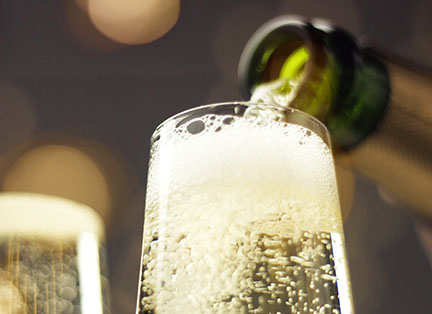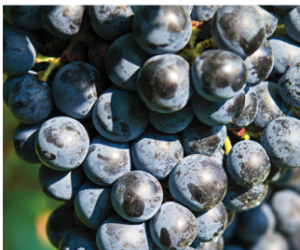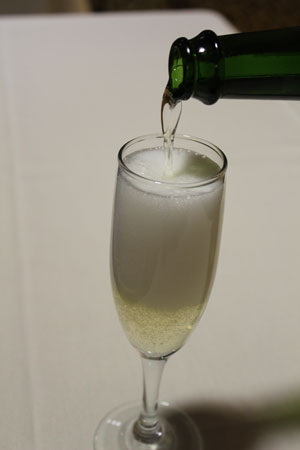Whether it’s the rush from the pop of the cork, the anticipation created watching the bubbles seem to explode from the glass, or the flavors that dance on your palate as you sip . . . there is no denying that there is a certain romance to sparkling wines. And creating your own sparkling wine is actually not all that hard to do. For hobby winemakers, we can lump sparkling winemaking into four distinct production techniques: Méthode Champenoise (traditional Champagne), Charmat method (Italian sparkling), méthode ancestrale (pétillant-naturel or pét-nat for short), and country-style. In this piece my goal is not to give you step-by-steps of producing sparkling wines, but rather an introduction to the methods of producing them at home.
Sparkling Basics
First things first, there are basically two formats when it comes to the carbonation found in wine: Sparkling and still. Simply put sparkling means the wine is carbonated while still wines are left mostly uncarbonated. There are some times when a still wine will become sparkling due to the production of an unstable wine. This is definitely something all winemakers should avoid and wines can be unstable for several reasons, but is most commonly due to insufficient sulfite levels when bottling (especially wines that have not gone through malolactic fermentation), backsweetening (adding sugars) before bottling, or a combination of both. Also, just because most sparkling wines you see at your favorite wine store are either going to be whites or rosés, that doesn’t mean you should not produce red sparkling wines. In fact red sparkling wines are quite popular as well. But often they are made from lighter, low-tannin, fruitier varieties . . . you’ll want to leave your big, tannic-laden grapes for still wine production. If you plan to bottle sparkling wine it must be placed in thick-walled sparkling wine bottles with proper closures. These bottles are made to withstand up to 100 psi of pressure. Finally, when carbonation occurs in the bottle, the wines need to remain unsulfited so a degree of instability does exist.
Méthode Champenoise

While this technique produces what most wine aficionados would consider the highest form of sparkling wine, it comes at a fairly high cost in terms of production effort and time. In this style, the wine is fermented to completion (dry) and then fined and filtered in order to stabilize it. For bottling, a measured dosage of sugar is added to the wine along with some fresh yeast and mixed well. The wine is bottled then capped with bidules and crown caps (think beer cap with a little bowl on the inside of it). The fresh yeast will consume the sugar and produce a sparkling wine.
Often these wines will be allowed to age a year to five years (or more!) in the bottles with the yeast. The next step is the riddling process. This process starts with the bottle being angled so that any sediment starts to slide towards the cap and bidule. Over the course of several weeks the bottles are slowly turned to help aid this settling process. Once the winemaker is happy with the settling process, it’s time to disgorge the yeast from the bottles. This disgorgement process starts with a saturated salt-ice bath, which is used to freeze the necks of the wine bottles. Once frozen, the crown cap is removed and the yeast is expelled from the pressure. The bottles are topped back up and corked. If you’re interested in reading more on this technique, check out the June-July 2019 issue or that article can be found at https://winemakermag.com/article/methode-champenoise.
Charmat Method
Homebrewers generally refer to this technique as forced carbonation, but in the wine world it is used extensively in Italy for production of sparkling wines such as Prosecco. The beauty of the Charmat method is in its simplicity . . .but its downfall is in the equipment needs. Basically you need a kegging system. Cornelius kegs are popular in the homebrew world to force carbonate beer and can be used for carbonating wines too. A carbon dioxide tank and regulator (to control the pressure in the keg) are also needed as well as a faucet to serve the sparkling wine or bottle it. A counter-pressure filling system is required if you want to bottle. For carbonation levels, I recommend starting around 30 psi and you can go up or down from there. For more on this style of sparkling wine, check out the April-May 2019 issue or https://winemakermag.com/technique/italian-techniques-for-bubbles.
Méthode Ancestrale
A third alternative to crafting sparkling wines comes in the form of what is popularly known as pét-nat wines. While méthode Champenoise is time and effort intensive, Charmat method is equipment intensive, méthode ancestrale is neither . . . but a thorough understanding of expected outcomes is required to achieve your desired results in terms of sweetness and carbonation levels. Basically the wine is fermented down to a certain degree Brix (incomplete fermentation), and then packaged in thick-walled sparkling wine bottles with fermentation finishing in the bottle. Some diligence is required while tracking fermentation progress and winemakers need to be ready to bottle at a moment’s notice. For more on this style check out the June-July 2021 issue or https://winemakermag.com/article/pet-projects.
Country-Style Sparkling
A cross between the méthode Champenoise and méthode ancestrale approaches is the country-style sparkling wine. The wine is fermented until dry, then during the bottling process a measured dose of sugar is blended into solution. The yeast consumes the added sugar which produces the desired carbonation.






